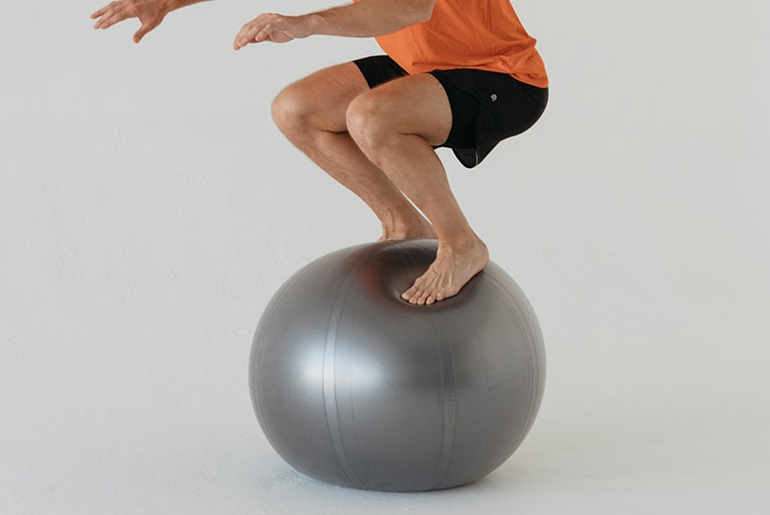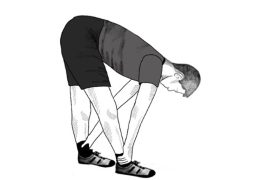The Swiss ball step-up is a dynamic lower body exercise that utilizes a Swiss ball for added challenge and balance. To perform this exercise, one foot is placed firmly on top of the ball, while the other foot remains on the ground. By pushing through the heel of the foot on the ball, the body is lifted upward into a standing position, engaging the quadriceps, hamstrings, and glutes, as well as the core muscles for stability. Controlled movements are crucial to maintain proper form and prevent injury. This exercise not only strengthens the lower body but also enhances balance and coordination. Adjustments in step-up height and movement speed allow for customization to individual fitness levels and goals.
Swiss Ball Step-Up:
The Swiss ball step-up is a challenging lower body exercise that involves stepping onto and off of a stability ball. Here’s how to perform the Swiss ball step-up:
- Setup: Place a stability ball on the ground in front of a stable surface, such as a bench or step. Position yourself facing the bench with the stability ball between you and the bench.
- Starting Position: Stand tall with your feet shoulder-width apart and parallel to each other. Keep your core engaged and your shoulders relaxed.
- Step onto the Ball: Lift one foot and place it securely on top of the stability ball, ensuring that the entire foot is supported on the ball. Keep your weight centered over the foot on the ball.
- Drive Through the Heel: Press through the heel of the foot on the ball to lift your body up onto the ball. Use your glutes, hamstrings, and quadriceps to drive the movement.
- Full Extension: Stand up tall on the ball, fully extending your hips and knees. Keep your core engaged to maintain balance and stability.
- Step Down: Slowly lower yourself back down to the starting position by bending your knee and hip, allowing your other foot to touch the ground next to the stability ball.
- Repeat: Perform the desired number of repetitions on one leg before switching to the other leg. Keep the movement controlled and deliberate, focusing on maintaining balance and stability throughout.
Tips for Proper Form:
- Keep your chest up and your gaze forward throughout the exercise to help maintain balance.
- Engage your core muscles to stabilize your body and prevent excessive swaying or tilting.
- Use a bench or step that is at a comfortable height for you, ensuring that you can safely step onto and off of the stability ball.
- Start with a lower bench height or perform the exercise without weights to master the movement before progressing to more challenging variations.
The Swiss ball step-up is an advanced exercise that requires coordination, balance, and lower body strength. It targets the quadriceps, hamstrings, glutes, and calf muscles while also engaging the core for stability. Incorporate this exercise into your lower body workout routine to challenge yourself and improve functional strength and balance.
Rewards:
- Core Engagement: Performing step-ups on a Swiss ball requires significant core stabilization to maintain balance. This engagement of core muscles helps strengthen the abdominals, obliques, and lower back.
- Balance and Coordination: Stepping onto and off of a stability ball challenges balance and coordination, helping to improve proprioception and neuromuscular control.
- Lower Body Strength: The primary muscles targeted during Swiss ball step-ups include the quadriceps, hamstrings, glutes, and calves. This exercise can help build strength and muscle tone in the lower body.
- Functional Movement: Step-ups mimic movements used in daily activities like climbing stairs or stepping onto a curb, making them a functional exercise that can improve overall mobility and stability.
Risks:
- Falls and Injuries: Performing step-ups on a stability ball increases the risk of falling, especially for individuals who struggle with balance or have limited experience with stability training. Falls from the ball can result in injuries such as sprains, strains, or even fractures.
- Overloading the Ball: Depending on the size and quality of the stability ball, it may not be able to support the weight of the individual performing the exercise. Overloading the ball can cause it to burst or deflate suddenly, leading to injury.
- Spinal Instability: Individuals with pre-existing back issues or poor spinal stability may experience discomfort or exacerbation of symptoms when performing Swiss ball step-ups. The instability of the ball can place additional stress on the spine, increasing the risk of injury.
- Improper Form: Performing step-ups on a stability ball requires proper technique to ensure safety and effectiveness. Without adequate instruction and supervision, individuals may inadvertently use incorrect form, increasing the risk of injury.
Conclusion:
The Swiss ball step-up can be a valuable addition to a well-rounded workout routine, providing benefits such as core engagement, balance improvement, and lower body strength development. However, it’s essential to approach this exercise with caution and mindfulness of the associated risks. Individuals should ensure they have sufficient core strength and stability before attempting Swiss ball step-ups and seek guidance from a qualified fitness professional to learn proper technique and progression. As with any exercise, listening to your body and stopping if you experience pain or discomfort is paramount to preventing injury.
Disclaimer:
The information contained in this article is for educational and informational purposes only and is not intended as a health advice. We would ask you to consult a qualified professional or medical expert to gain additional knowledge before you choose to consume any product or perform any exercise.







